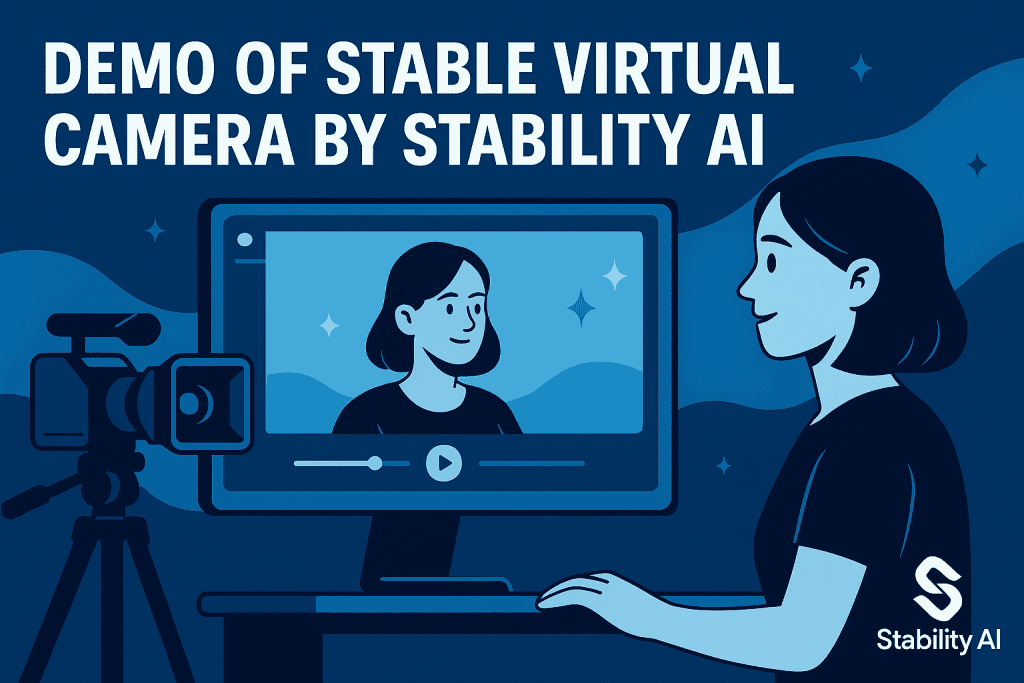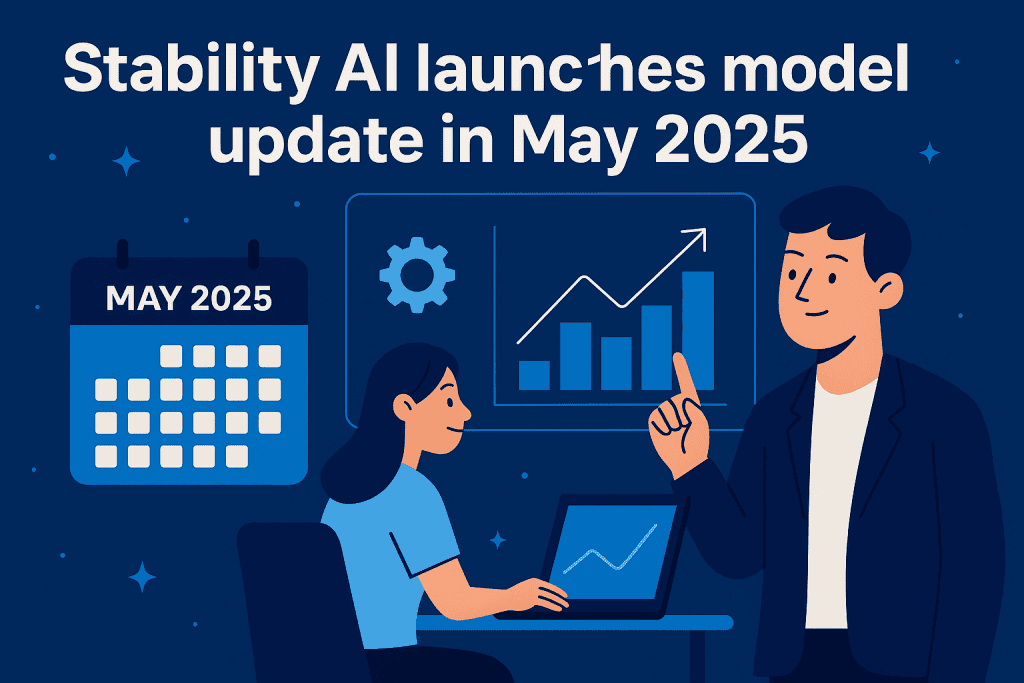인공지능은 빠르게 진화하고 있으며, 안정성 AI는 창의적인 기술에 더 쉽게 접근할 수 있는 도구로 그 길을 선도하고 있습니다. 이들의 플랫폼인 Stable Diffusion은 이미 사람들이 간단한 프롬프트를 멋진 비주얼로 바꾸는 방식을 변화시켰습니다. 하지만 이제 안정성 AI는 그 이상을 향해 나아가고 있습니다. 스테이블 버추얼 카메라를 포함한 최신 업데이트를 통해 사용자는 기술이나 고가의 소프트웨어 없이도 평면 이미지를 시네마틱 효과가 있는 3D 장면으로 변환할 수 있습니다. 이는 전문 팀과 도구가 필요했던 콘텐츠를 일반 사용자도 제작할 수 있도록 지원하는 중요한 변화입니다.
더욱 흥미로운 점은 안정성 AI의 명확한 미래 방향성입니다. 로드맵에 따르면 향후 출시될 기능은 더 빠른 성능, 더 높은 시각적 품질, 더 많은 사용자 제어 기능에 초점을 맞출 예정입니다. 이러한 변화는 단순히 더 보기 좋게 만드는 것이 아니라 더 많은 사람들이 시각적 스토리텔링을 통해 아이디어를 표현할 수 있는 힘을 부여하는 것입니다. 이제 아티스트, 교육자, 마케터, 개발자 모두 더 적은 시간과 노력으로 인상적인 결과물을 만들 수 있습니다. 안정성 AI는 강력한 크리에이티브 도구가 더 이상 전문가에게만 국한되지 않고 비전을 가진 사람이라면 누구나 사용할 수 있도록 지원합니다.
일어난 일

2025년 5월, 스테이블리티 AI는 획기적인 기능인 스테이블리티 가상 카메라를 출시해 화제를 모았습니다. 이 도구는 하나의 2D 이미지를 완전한 애니메이션 3D 동영상으로 변환하여 깊이, 공간, 움직임이 있는 듯한 착각을 불러일으키도록 설계되었습니다. 360도 회전, 나선형, 돌리 줌과 같은 복잡한 카메라 움직임을 시뮬레이션할 수 있다는 점이 이 툴의 차별화 포인트입니다. 일반적으로 대규모 영화 제작에 사용되는 기술입니다. 이 툴은 32심도 레이어 매핑 시스템을 사용하여 평면 이미지 내에서 공간 깊이를 지능적으로 이해하고 재현하여 이전에는 존재하지 않았던 공간에 생동감과 움직임을 더할 수 있습니다.
가장 인상적인 기능 중 하나는 최대 1000프레임까지 3D 일관성을 유지한다는 점입니다. 이를 통해 결과물인 비디오가 전체적으로 안정적이고 시각적으로 일관된 상태를 유지하여 유사한 도구에서 발생할 수 있는 일반적인 왜곡과 결함을 제거합니다. 안정적인 가상 카메라는 단순히 비주얼을 향상시키는 데 그치지 않고 사람들이 이야기를 전달하고, 개념을 가르치고, 아이디어를 표현하는 방식을 혁신합니다. 아티스트는 정지된 작품에 애니메이션을 적용하고, 교육자는 역사적 장면이나 과학 도표에 생동감을 불어넣고, 마케터는 매력적인 제품 비주얼을 쉽게 제작할 수 있습니다.
이번 출시는 강력한 크리에이티브 툴의 접근성을 높이기 위한 안정성 AI의 지속적인 노력을 반영합니다. 이제 사용자는 이미지 하나만 있으면 전문 지식과 장비가 필요했던 전문가 수준의 애니메이션을 제작할 수 있습니다. 이는 간소화되고 영향력 있는 시각적 스토리텔링의 새로운 시대를 열었습니다.
이번 릴리스는 크리에이터와 개발자의 역량을 강화하기 위한 지속적인 노력의 일환입니다. 단순히 화려한 기능이 아니라 스토리텔링, 시뮬레이션, 심지어 교육을 위한 완전히 새로운 형식의 문을 열어줍니다.
언제 어디서

2025년 5월 안정성 AI의 새로운 Stable 가상 카메라 발표는 최대한 많은 사람들에게 알리기 위해 신중하게 계획되었습니다. 유튜브와 트위터를 주요 출시 플랫폼으로 사용하여 즉각적인 가시성과 상호 작용을 보장했습니다. 이러한 채널은 속도가 빠를 뿐만 아니라 디지털 크리에이터, 개발자, AI 애호가들이 널리 사용하고 있어 기술 뉴스를 전파하는 데 적합합니다. 실용적이고 창의적인 AI 도구에 대한 관심이 최고조에 달한 시기를 활용한 출시 타이밍도 중요했습니다.
발표 직후 데모 동영상은 수천 건의 조회수를 기록했고, Reddit, Discord, 크리에이티브 포럼과 같은 플랫폼에서 대화가 활발하게 이루어졌습니다. 사용자들은 빠르게 자신의 생각을 공유하고, 질문하고, 새로운 기능을 실험해 보았습니다. 이러한 즉각적인 피드백 루프는 도구의 가시성을 높이는 데 도움이 되었고, 안정성 AI는 실제 사용자가 이 도구를 어떻게 사용하는지 파악할 수 있었습니다. 출시와 관련된 소문은 디지털 플랫폼이 마케팅뿐만 아니라 커뮤니티와 신뢰를 구축하는 데 얼마나 효과적인지 보여줍니다.
참여 대상

안정적인 가상 카메라 출시에서 에멧 황의 역할은 단순한 홍보를 넘어 개발자와 대중을 잇는 가교 역할을 했습니다. 간단하고 매력적인 언어로 도구를 설명하는 그의 능력 덕분에 기술 전문가가 아닌 청중도 복잡한 기술을 쉽게 이해할 수 있었습니다. 그는 주요 기능을 강조하고 실제 사용 사례를 시연함으로써 흥미와 신뢰를 불러일으켰습니다. 첨단 기술에 대한 접근성을 높인 그의 명성은 출시에 신뢰성을 더했고, 기술계를 넘어 커뮤니티 전반으로 영향력을 확대했습니다.
이 성공적인 출시 뒤에는 안정성 AI의 다양한 글로벌 팀이 있었습니다. Stable 가상 카메라의 개발에는 소프트웨어 엔지니어, UI 디자이너, 열정적인 오픈소스 기여자들이 함께했습니다. 이러한 기여자들은 종종 자신의 시간과 통찰력을 자원하여 툴을 테스트, 개선 및 개선하는 데 중요한 역할을 했습니다. 이러한 협업 모델을 통해 팀은 문제에 신속하게 대응하고 실시간으로 피드백을 적용하며 실제 사용자의 요구를 반영한 제품을 구축할 수 있었습니다. 이 릴리스는 첨단 기술을 강력할 뿐만 아니라 모든 사람이 진정으로 사용할 수 있도록 만든다는 공동의 사명을 공유하는 팀이 어떤 성과를 거둘 수 있는지 보여줍니다.
중요한 이유
스테이블리티 AI의 최근 개발이 중요한 이유는 일반 사용자들이 고급 크리에이티브 기술에 더 쉽게 접근할 수 있게 되었기 때문입니다. 기존에는 3D 애니메이션이나 몰입형 동영상 콘텐츠를 제작하려면 고가의 소프트웨어, 강력한 컴퓨터, 전문 기술이 필요했습니다. 이제 스테이블 버추얼 카메라를 사용하면 단순한 2D 이미지를 부드럽고 영화 같은 카메라 효과로 풍부한 3D 비디오 장면으로 전환할 수 있습니다. 이 획기적인 기능은 아티스트와 영화 제작자뿐만 아니라 교육자, 마케터, 게임 디자이너 등 시각적 스토리를 보다 역동적인 방식으로 전달하고자 하는 모든 사람에게 도움이 됩니다.
또 다른 주요 변화는 이 도구가 AMD Radeon GPU에 최적화되었다는 점입니다. 수년 동안 Nvidia는 AI 처리 성능을 위해 많은 노력을 기울여 왔지만, 다른 시스템을 사용하는 사람들에게는 비용이 많이 들거나 액세스가 제한되는 경우가 많았습니다. AMD 하드웨어를 지원함으로써 안정성 AI는 더 많은 크리에이터와 개발자에게 문호를 개방하여 이러한 툴을 사용하는 방법과 장소에 더 많은 유연성을 부여하고 있습니다. 이는 하드웨어 비용을 절감하고 예산이 많지 않은 학교, 스타트업 및 독립 아티스트의 가능성을 넓혀줍니다.
전반적으로 이번 업데이트는 제너레이티브 AI가 참신함을 넘어 실생활에서 사용할 수 있는 실용적인 도구로 거듭나고 있음을 보여줍니다. 더 이상 재미로만 제작하는 것이 아니라 모든 배경을 가진 사람들이 전문가 수준의 콘텐츠를 제작하고, 시각적으로 문제를 해결하고, 보다 창의적이고 의미 있는 방식으로 청중을 참여시킬 수 있도록 지원합니다.
인용문 또는 진술
결론
스테이블 AI의 최근 개발, 특히 스테이블 가상 카메라의 출시는 더 많은 사람들이 고급 기술을 더 쉽게 사용할 수 있도록 하는 데 초점을 맞추고 있음을 보여줍니다. 이러한 도구를 전문가에게만 한정하지 않고 모든 배경의 아티스트, 교육자, 크리에이터가 이해하고 적용할 수 있는 기능을 설계하고 있습니다. 또한 안정적 확산 로드맵은 창작의 자유와 기술적 효율성을 개선하기 위한 더 많은 혁신이 진행 중임을 시사합니다.
이는 단순한 업그레이드가 아니라 앞으로 사람들이 이미지, 동영상, 디자인과 상호 작용하는 방식에 변화를 가져올 것입니다. AI가 계속 성장함에 따라 안정성 AI는 화려한 실험이 아닌 실제 유용성에 초점을 맞춘 점이 돋보입니다. 이들의 연구는 전문가뿐만 아니라 누구나 몇 단계만 거치면 접근하기 쉬운 도구로 아이디어를 고품질의 시각적 결과물로 전환할 수 있는 미래를 만드는 데 기여하고 있습니다.
리소스
- 안정성 AI. 공식 웹사이트
- 안정성 AI. 이제 AMD Radeon GPU에 최적화된 안정적 확산
- 안정성 AI. GitHub – 생성 모델
- AWS. 아마존 베드락의 안정성 AI
- 크런치베이스. 안정성 AI 프로필
- YouTube. 안정적인 가상 카메라 데모
